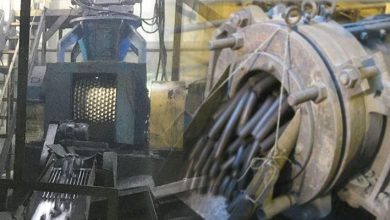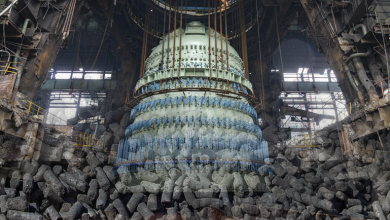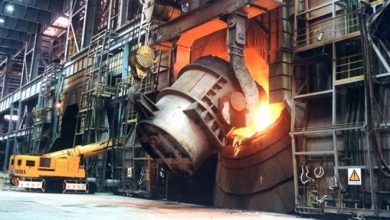Why choose briquetting rather sintering to deal with the sludge in steel plant
As the steel industry continues to pay attention to environmental protection, its profit margins continue to decline. The comprehensive utilization of metallurgical solid waste resources is an effective way for the steel industry to achieve sustainable development, reduce costs and increase efficiency, and improve the competitiveness of steel companies. Converter dust has the characteristics of fine particle size (5-74.6 μm) and high iron content (about 50% of TFe), which is a valuable by-product. Effective recycling of it can eliminate environmental pollution and realize iron and steel production. Production of low-emission environmental protection requirements. If the sludge treatment adopts the long steel-making process, due to its high iron ratio, it needs to be added to the sintering ingredients after being extruded to remove part of the water. However, the sewage of OG sludge is easy to flow to the road during transportation, and by-product dust is likely to be generated during the transportation of steelmaking dust removal dust, which pollutes the environment of the steel factory. Steelmaking OG sludge has high moisture and steelmaking dust has a fine particle size. In the sintering ingredients, the air permeability of the sintered material will be deteriorated, the effective air volume passing through the material layer will be reduced, the vertical sintering speed will be affected, and the quality of the sintered ore will be reduced. Therefore, sintering is not a good choice for these wastes. With the development of sludge dewatering technology, making sludge briquette with additives from steelmaking sludge and returning it to steelmaking as a converter slagging agent and coolant is a relatively more mature process. Moreover, the above-mentioned problems can be solved.
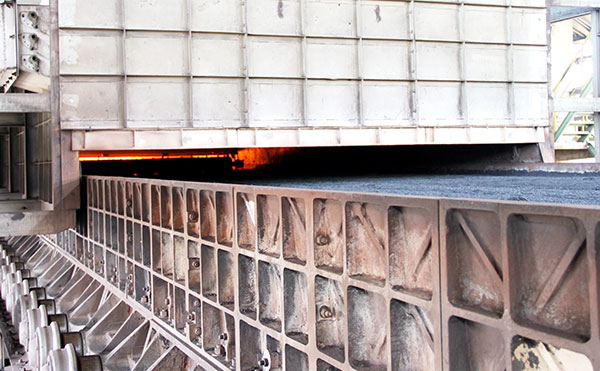
The theoretical basis of sludge briquette making
speed up slagging
Because the content of iron in sludge briquette is relatively high, adding sludge briquette in the initial stage of converter blowing will increase the content of FeO in the initial slag. Due to the high content of FeO in the slag, the fluidity of the slag is good, and FeO can form calcium ferrite low-melting point compound with lime to melt the lime. And it can prevent lime and SiO2 in slag from forming refractory 2CaO·SiO2, and is also beneficial to lime melting. Coupled with a part of CaO brought in by the sludge briquette, the consumption of lime is reduced and the speed of slagging is accelerated.
Improving the dephosphorization effect at the initial stage of blowing
Converter dephosphorization is mainly at the initial stage of blowing, and there are three main conditions: high alkalinity (R), high oxidation (high FeO), and low temperature. In the initial stage of converter blowing, the temperature in the furnace is relatively low, which satisfies the low temperature condition. The addition of sludge briquette increases the content of FeO in the slag, which satisfies the condition of high oxidative properties of the slag. It accelerates the melting of lime (CaO) and satisfies the condition of high alkalinity of slag. The three main conditions for converter dephosphorization are met, which promotes the chemical reaction of dephosphorization.
The time when adding the sludge briquette
Adding in the mid-stage of blowing and using sludge briquette to dissolve slag
Adding sludge briquette in the middle stage of converter blowing can increase the content of FeO in the slag, effectively promote the melting of slag, reduce the burden of using the adjustment gun position to generate FeO, and can make up for the intense consumption of a large amount of carbon-oxygen reaction in the middle stage of blowing. FeO, resulting in insufficient FeO in slag. After using the sludge briquette, the iron oxide in the slag can be guaranteed to meet the needs of smelting. This can effectively reduce the amount of molten iron of iron oxide oxidized by oxygen, reduce the blowing loss of molten iron, and reduce the consumption of metal materials.
Adding at the end of blowing, using sludge briquette to prevent rephosphorization
Adding sludge briquette in the later stage of converter blowing can increase the FeO content in slag, and meanwhile sludge briquette can be used as a coolant to reduce the temperature in the furnace, promote the positive dephosphorization reaction, and prevent the occurrence of high temperature rephosphorization.
Sludge briquette making – raw material and condition
Steel residual sludge briquette is an auxiliary raw material used in converter steelmaking production. The requirements for its composition are mainly reflected in meeting the needs of the smelting process and the proportion of the production process. The effect of using the comparative ore is equivalent or similar. In view of the raw material characteristics of steelmaking sludge briquette, which are mainly reflected in iron content, impurity elements and slagging substances, etc., it is required to have a certain iron content, low impurity elements and certain slagging ability in its use. The requirements of the ratio of the production process on sludge briquette are mainly reflected in maximizing the utilization of resources and having a certain alkalinity, which is beneficial to smelting reactions and slag melting. Mix steelmaking converter sludge (OG sludge), mill scale, steelmaking secondary dust removal dry ash, water treatment sludge and add steel rolling mill scale to increase the iron content. After dosing, the iron content reaches 50%, which can be used as lngredients for sludge briquette. Choose the sludge briquetting technology, use sludge briquette as converter coolant and slagging agent, and meet the condition of adding 20 kg sludge briquette per ton of steel in the converter steelmaking process.
The process of sludge briquette making
Transport the OG sludge and water-treated oil sludge filtered through the steelmaking process to the drying area in the factory to dry to low moisture, then mix them together and go through the drum dryer to further reduce its moisture. The dry ash of the secondary dedusting is transported to the dust sludge briquetting raw material area by trucks and transported to the raw material bin by the conveying device. The mill scale and coarse particles are transported to the raw material bin of the briquette facility by the dump truck. The dried OG sludge, water treatment oil sludge, steelmaking dust, mill scale, and coarse particles are weighed and dosed by the weighing machine according to a certain proportion, and then mixed with the binder in the intensive mixer, and finally briquetted by the sludge briquette machine. Output briquette is blocked and sieved to obtain qualified briquettes, and the reject powder under the sieve is returned to the buffer silo for briquetting again. Qualified briquettes are sent to the dryer for drying or natural drying, so that the moisture of the green briquettes is reduced to the required moisture, and then sent to the finished product yard by the belt conveyor, and sent to the steelmaking furnace charge area by truck when needed. The binder is prepared and added by a special binder system. The sludge briquette system which designed by Maxton, except that the process of raw material drying and silo feeding requires manual intervention, the rest of the process, from dosing to mixing, briquetting, and drying, are all fully automatic control. In normal production, only equipment monitoring is required.
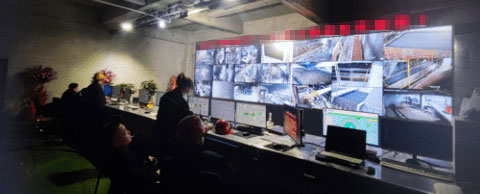
The performance of sludge briquette from steel residual
Size
During the smelting process of the converter, the carbon and oxygen in the molten pool react to generate a large amount of CO gas, which flows from the mouth of the converter to the petticoat and enters the converter for dust removal. If the particle size of the sludge briquette is too small, it will be taken away with the furnace gas. Normally the size shall be between 30 to 50 mm to enter the molten pool to meet the needs of steelmaking production.
Strength
If the strength of the sludge briquette is insufficient, it will be broken into small particles during the addition process and will be directly taken away with furnace gas, which will increase the burden on the dust removal system and cause pollution to the environment. A binder is added to the ingredients to form a solid-phase cohesive force, so that the sludge briquette has a certain strength. Practice has proved that both the compressive strength and drum strength of the sludge briquette can meet the requirements to be used in a converter furnace.
Density
The density of sludge briquette is about 2.29-2.56g/cm3, which is close to the density level of converter slag. The density of slag is normally 2.2-2.6g/cm3, and the density of ore is 4.8-5.3g/cm3. Compared with sludge briquette, it is more beneficial to participate in the slag-steel interface reaction in the actual smelting of the converter, and obtain a better dephosphorization effect.
Sections in the briquette system
Raw material drying section
The water content of OG sludge and water-treated oil sludge after drying is relatively high, further dehydration is required. It is dried by a drum dryer, the heat source can be purified converter gas from a steel plant.
Dosing section
The materials are transported to the respective silos by the conveying device, and the fine materials are connected to the metering device through the valve, then sent to the down conveyor through the metering device. The rest of the materials enter the down conveyor through the valve and unloader.
Materials are dosed individually by the meterig and feeding devices, then output by the down conveyor.
Briquetting section
The hydrarated material and binder are fully mixed through the mixing operation, then the mixed material enters the equipment for briquetting. Roll briquette machine is one of the main equipment of this process, and the briquetting function is finally completed by this equipment. This link is mainly composed of sludge briquette machine, screen, and feeding system.
Finished briquette drying section
Spread the briquettes evenly on the dryer’s belt and send them into the dryer. The green briquettes move back and forth in the dryer. At the same time, hot air is blown in, water vapor is discharged to reduce the moisture to a required level.
Dust collecting section
The dust removal adopts the combination of cyclone and pulse bag dust collector, which mainly collects the flue gas and dust generated by the raw material drying section and the finished briquette drying section. The down part of the cyclone dust collector is equipped with an ash discharge device, and the ash is recycled after being returned to the raw material system. The mass concentration of the exhaust gas after purification is less than 20 mg/Nm3, which has reached a very high standard.
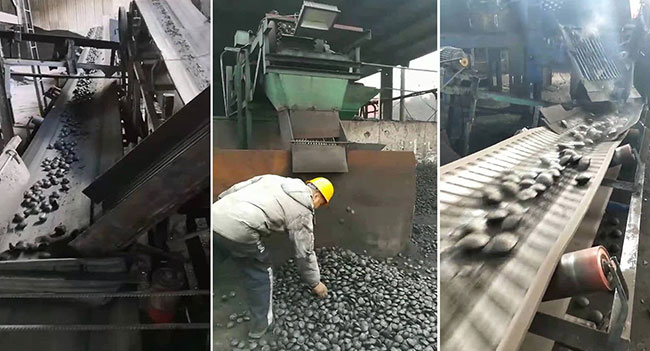
Things we pay attention to make the system more environment friendly
- The dosing, mixing, and briquette processes for preparing sludge briquette from iron dust are all operated at room temperature. If circulating hot air is used as the drying medium in the production process, no SO2 and NOx will be produced. The hot air burned by the purified converter gas is a good drying heat source. Converter gas basically does not contain SO2 and NOx, and the drying temperature is 250-300 °C. It is burned by low-temperature and low-oxygen burners, which is far lower than the formation temperature of NOx at 1500 °C.
- Organic binders can be used in the mixing process, which does not contain harmful components such as sulfur and phosphorus, and are environmentally friendly.
- In the production process, all dry powder enters the factory using closed tankers to transport the dry powder of various steel mills to their respective silos, avoiding the phenomenon of secondary dust.
- Washing water from workshops and vehicles can be mixed into the turbid water circulation system of the factory area, and reused through sedimentation and clarification. Dust and sludge are regularly cleaned and recycled into the raw material system of the drying yard. The reuse rate of production water can be up to 95%, reducing environmental pollution.



